RAF and others: ultra-leftist in post-war FRG
Based on the "new left" 1960's. formed the famous autonomous movement. Back in 1980, sociologists and political scientists argued about the gradual decline of the German leftists, but after 10 years they had to change their views on the political situation in the country. Since the middle of 1990-x in Germany, the relative rise of the left-radical movement has been observed. The basis of this recovery, of course, lies a number of socio-economic factors.
The first factor is the consequences of reunification with the GDR. Residents of the latter were financially better off than their compatriots from West Germany, and in addition to this, unemployment was much stronger in the east. This led to internal migration from the ex-GDR to the western half of the country.
Secondly, the problem of migration and its consequences for German society is very relevant. Now in Germany there are several million immigrants from Turkey - Turks and Kurds, and many of them belong to Turkish or Kurdish left-wing radical organizations. Germany has the largest representative offices in Europe of the Turkish and Kurdish left-radical groups, including the armed organizations of the Kurdish Workers Party and the Turkish Marxist-Leninist Party.
Another reason for the growth of left-wing sentiments among the West German youth proper was the strengthening of the political positions of the ultra-right parties. The growing influence of nationalists provokes a backlash from that part of the German political spectrum, which is focused on radical leftist ideas, which at present represent rather a kind of hard variation of liberal ideology: anti-fascism, internationalism and tolerance, humanism, ecologism, support for sexual and national minorities.
Considering the social composition of the German ultra-leftists, one can come to about the same conclusion, which at one time came from the well-known sociologist of the Frankfurt School, Herbert Marcuse - in today's society, the proletariat would take the leading place in the revolutionary struggle. "Outsiders", to which he attributed both the young intelligentsia and the students, and the declassed elements, foreign emigrants, national and sexual minorities. In addition to student youth and radical intellectuals, unemployed young people, as a rule, come from the East German federal states in the ranks of the German left.
The share of Turkish, Kurdish or Arab emigrants in the German ultraleft groups themselves is small, since the latter have their own numerous organizations that also operate in the territory of the Federal Republic. As for the "centers" of the left-radical movement, such traditionally include Berlin (especially its part, which used to be called West Berlin), Frankfurt am Main, Munich.
Violent students and urban partisans
The immediate predecessor of the modern German left-wing movement can be considered the “new left” movement, which became widely known due to the mass student unrest in Europe in the late 60 (the peak fell on 1967-68) and the wave of urban ultra-left groups that followed.
The emergence of the “new left” movement comes at the end of the 1950s — the beginning of the 60s, when the theory of the Frankfurt school, existentialist philosopher Jean-Paul Sartre and the American “critical sociologist” Charles R. Mills . The pro-Soviet communist parties accused the new leftists of opportunism and betrayal of communist ideals, so soon Trotsky and Mao Zedong became symbols of the movement. At the same time, interest arose in the forgotten works of Proudhon, Bakunin, Kropotkin and other anarchist theorists. Left-wing radical ideas gained special distribution in university centers.
The Socialist Union of German Students (SDS) became the largest organization of the left-radical student youth of Germany in the 1960-s. Initially, the VTS existed as a youth (student) organization under the Social Democratic Party of Germany. However, in 1960, the VTS was expelled from the party and in fact moved to the position of a “new left” movement. This “deviation from the left” was largely caused by the activities of the left-wing radical magazine “Concrete”, published by Klaus Rainer Rell and his wife Ulricoy Meinhof. The management of the VTS was carried out by Rudi Duchke, Berndt Rabel and Jürgen Kral. But the true leader of the Socialist Union of German students was still the same Rudi Duchke (1940-1979). A student - philosopher from the Free University of West Berlin, Duchke studied Marxism and existentialism, and in 1962 founded "Subversive Action" - the German section of Situationalist International (French radical artistic and political organization created by the philosopher Guy Debor and his like-minded group). During his student speeches, Duchke gained all-German and even pan-European fame as a brilliant speaker and organizer.
The second center of West German left radicalism after the SDS was the communard movement. At the end of the 1960s, Germany, like other Western countries, was literally overwhelmed by the real boom of the communes, which coincided with the heyday of the hippie movement. The largest communes operated in West Berlin and Munich. West Berlin hippies created Commune No. 1.
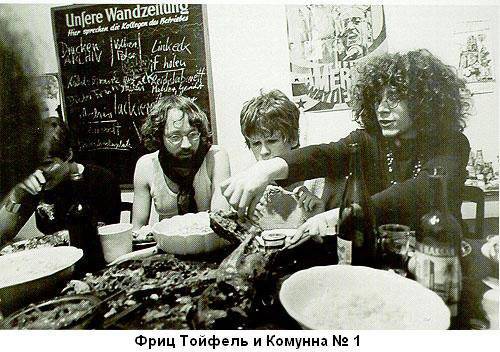 From the Commune number 1 originates almost all the left-radical terrorism of Germany 1970-s. The organizers of the Commune number 1 were counterculture figures Fritz Teufel and Rainer Langhans, regular participants of happening and alternative festivals. Contrary to popular belief, hippies who lived in Commune No. 1 had an interest not only in drugs, group sex and rock concerts, but also in political actions. Subsequently, the "founding fathers" of the Red Army Faction, including Andreas Baader, left the Commune No. 1.
From the Commune number 1 originates almost all the left-radical terrorism of Germany 1970-s. The organizers of the Commune number 1 were counterculture figures Fritz Teufel and Rainer Langhans, regular participants of happening and alternative festivals. Contrary to popular belief, hippies who lived in Commune No. 1 had an interest not only in drugs, group sex and rock concerts, but also in political actions. Subsequently, the "founding fathers" of the Red Army Faction, including Andreas Baader, left the Commune No. 1. The reason for the transition of the German ultra-left to terrorist actions was the killing of 2 on June 1967 of the year in a demonstration against the visit of the Iranian Shah of 23-year-old student Benno Onazorg, which caused a storm of indignation among radical youth. And after 12 in March 1968 was killed by the police, Karl Kunz, who attempted to attack a big businessman, the new left decided to move on to more extremist actions from demonstrations.
2 April 1968, Andreas Baader, Gudrun Enslin, Thorvald Prol and Horst Zonlein blew up a bomb in one of the shops in Frankfurt am Main. This date can be considered the beginning. stories urban guerrilla war, which the German ultra-left launched against the authorities of Germany. In 1970, Baader, Enslin and lawyer Horst Mahler, who joined them, and journalist Ulrika Meinhof created the Red Army Faction group, which has become the most famous terrorist organization in modern Germany. Ideologically, the RAF was focused on Maoism and considered its activities as part of the global armed struggle against imperialism. The RAF considered terrorist activity as a means of awakening the revolutionary activity of the working masses and set the ultimate goal of turning the “revolutionary core” into a red army and creating red armies on a global scale.
The ideological basis of the RAF is the Maoist concept of confronting the world village (that is, third world countries and national liberation movements) and the world city (that is, the capitalist system). Despite the wide scope of activities, the number of RAFs did not exceed 200-300 people (unlike, say, from the close in spirit of the Italian Red Brigades, which consisted of several thousand radicals), the majority were from either fairly well-off families of the middle and large bourgeoisie, or declassed elements and bohemian. Researchers are talking about at least the "three generations" of the RAF. Almost all of the “first draft” activists were arrested or killed back in the 70s (only Horst Mahler survived from the four “historical leaders” of the RAF until today, who left the movement and is a liberal Free Democratic Party).
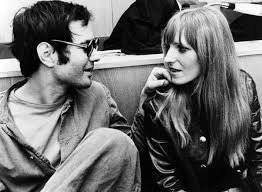 The loudest RAF operation was the abduction and murder of a prominent capitalist and right-wing politician Hans Martin Schleier in 1977 (after the murder of Schleyer, the police turned all their forces to catch the terrorists, but the RAF continued to haunt Germany for 15 years).
The loudest RAF operation was the abduction and murder of a prominent capitalist and right-wing politician Hans Martin Schleier in 1977 (after the murder of Schleyer, the police turned all their forces to catch the terrorists, but the RAF continued to haunt Germany for 15 years). Conventionally, German left-radical terrorism can be divided into two areas - pro-Maoist, represented by the RAF, and anarchist-communal, represented by a number of smaller left-wing groups. If in the case of the RAF we observe a more or less centralized and formed organization, then the anarchists acted more spontaneously.
On the basis of the West Berlin Commune No. 1, Fritz Teufel founded the June 2 Movement (D2), which became the second most important left-terrorist organization after the RAF. Unlike the RAF, the June 2 Movement was oriented toward the abstract opposition to Sistema, the consumer society, and since the majority of the group members were hippies and communes, its activities often contained dramatized moments and outright mockery of the bourgeois system (for example, the time of one of the raids on the bank, the communards fed the hostages with cupcakes, and Fritz Teufel stood on his head during the passing of the sentence in court, wanting to see his judges upside down). On the basis of the Munich commune (the so-called "Munich communards"), the Southern Front of Action arose, which did not last long and was defeated by the police in 1971.
In 1970, psychiatrists Wolfgang and Ursula Huber created the Socialist Patient Group (UPC) at the Bidelberg University, which included both the patients they observed and the psychology students who were fascinated by antipsychiatry that was popular at the time ). But the UPC did not exist for long and was soon defeated by the security organs, and from its remnants the Information Center of the Red People’s University was created, continuing its terrorist activities.
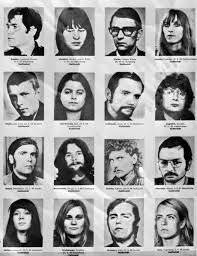 In 1973, in the same communard-anarchist environment, revolutionary cells (RZ) emerged, the leaders of which were Johannes Weinrich and Wilfried Meringue. The activities of the Revolutionary cells were closely intertwined with the activities of the international terrorist Ilyich Ramírez Sánchez (Carlos Shakal), so together with Carlos RZ they took hostage the ministers of the OPEC countries in 1974. The bulk of the RZ participants were activists from Rote Hilfe (Red Aid) and Schwarze Hilfe (Black Aid), organizations created to help political prisoners communists and anarchists. The wave of terror that peaked in the middle of the 1970s began to decline in the 1980s and, although the terrorist activities of the leftist groups do not cease to this day, their scope can no longer be compared with the 1970s.
In 1973, in the same communard-anarchist environment, revolutionary cells (RZ) emerged, the leaders of which were Johannes Weinrich and Wilfried Meringue. The activities of the Revolutionary cells were closely intertwined with the activities of the international terrorist Ilyich Ramírez Sánchez (Carlos Shakal), so together with Carlos RZ they took hostage the ministers of the OPEC countries in 1974. The bulk of the RZ participants were activists from Rote Hilfe (Red Aid) and Schwarze Hilfe (Black Aid), organizations created to help political prisoners communists and anarchists. The wave of terror that peaked in the middle of the 1970s began to decline in the 1980s and, although the terrorist activities of the leftist groups do not cease to this day, their scope can no longer be compared with the 1970s.Almost simultaneously with small terrorist organizations in the Federal Republic of Germany, numerous alternative squat movement emerged. Like the terrorist organizations, the squatting movement originated in West Berlin among students, hippies and immigrants from Turkey. Housing prices in Berlin were extremely high and not every student, not to mention the immigrants, could provide themselves with an apartment. More than 50 thousands of Berliners in the 1973 year lived in the open. The housing problem has led to the emergence of a whole movement, focused on the occupation of empty buildings and the organization in them of their communes - squats. According to the German Interior Ministry, there were about 1980 thousands of squatters in 150 in West Berlin, including 50 thousands of “normal citizens”, 40 thousands of hippies and punks, and about 50 thousands of Turkish immigrants.
Starting in December 1980, the police began a massive assault on squats in Berlin as well as in other German cities. The anti-squatting position of the authorities was also explained by the fact that, according to the police, a significant part of squatters took part in the activities of radical left-wing terrorist groups, while terrorists were hiding in squats. 13 March 1981 was named Black Friday. On this day, squatters throughout the country resisted the police, reaching real street battles. Thus, the development of the left-radical movement in 70-80-e years took place in two directions - a few terrorist groups (focused on Maoism or neo-anarchism) and the mass alternative movements of squatters, autonomists and green left. Naturally, during this period there were other political organizations, primarily Trotskyist or anarcho-syndicalist, but their influence was extremely insignificant. However, most of the currently existing German ultra-left factions originate in the "hectic sixties."
At the beginning of 1970, the mass student movement of the new left was waning. Rudy Duchke, after an assassination attempt by a Nazi fanatic, remained paralyzed and died in 1980 as a result of an accident. The second most popular student leader, Juergen Kral, after Duchka, died in a car accident. Left without bright leaders, the student movement has died down. Some of its participants have moved away from political activity in general, a significant part has moved to more moderate organizations, primarily the Social Democratic Party and the newly formed Green Party.
The activity of the new left since the middle of the 1970-s has been developing in two directions - the communal-alternativeist (mass movements of squatters and autonomists) and the terrorist. The latter included the most extremist groups of new leftists, inspired by examples of Latin American guerrilla. At the end of 80, the wave of radical left terrorism has decreased compared to 70, but the explosions and assassinations, for which left-wing extremists take responsibility, continue to this day.
In 1990-s. in the territory of the Federal Republic of Germany, at least 4, large organizations of urban partisans, are focused on the ideas of the new left and anarchism. They are the conglomerate Anti-Imperialist Resistance, Revolutionary Cells, Committee and Class vs. Class. Revolutionary cells (RZ) - perhaps the oldest of the existing terrorist groups of the new left. It was founded in 1973, with the active participation of many fighters of the 2 Movement of June, especially the terrorist girls. A distinctive feature of the RZ is a strongly feminist orientation - the group proclaims its goal, including the fight against the imperialist patriarchy.
In 1994, her women’s group, called Rote Zora (Red Wrath), carried out an explosion at shipyards in Bremen, hindering the fulfillment of the military order for the Turkish army. The number of RZs currently varies between 40-50 people, and two thirds of the militants are women. RZ publishes to promote its views magazine Rote Zora. The committee announced itself at 1994 by an explosion at a resort in Brandenburg. In 1995, the Committee attempted to blow up a federal prison in Berlin under construction. The Committee speaks of its ideological position as attempts to influence the authorities in order to prevent specific anti-people actions. The class against the class is the West Berlin group, consisting primarily of activists of the autonomist movement. She specializes in small-scale terrorist attacks, especially on the arsons of luxury cars (overnight autonomists from this group manage to destroy cars before 50) and the destruction of public and private property.
Anti-imperialist resistance (AS) was created in 1992 and represents a poorly organized conglomerate of left-wing radical terrorist groups seeking to develop a common strategy of forms and methods of warfare. A single point of view on the nature of the partisan struggle in the AU has not yet been worked out, and between the groups forming the movement there are ongoing discussions on the theory and practice of armed resistance. Within the AU, there are several main areas and points of view, which are held by one or another new-role organizations. The first direction, presented by the Frankfurt group “No Consent”, supports the organizational consolidation of the RAF militants who participated in the guerrilla in 80-s and participation, above all, in regional and anti-fascist basic initiatives. The main goal of the struggle is to create a new revolutionary counter-power from below, which will ultimately destroy the regime. Supporters of another direction, supported by the Initiative Left Offensive and the Yarama group of Mainz, insist that first of all guerrilla groups should be engaged in the release of prisoners of armed resistance.
According to this view, as long as at least one political prisoner is in government dungeons, the main task should be the struggle for liberation. The third direction proclaims that the main goal of the AU is the struggle against the imperialist patriarchy and the oppression of women by the capitalist system. Anarcho-feminist Revolutionary (RZ) cells that entered the Anti-imperialist resistance in 1995 adhere to this point of view. Finally, in the AU, there are groups that have the main goal of combating opposition to the strengthening of Germany and the militarization of its foreign policy, as well as groups that support the Kurdish, Turkish and Palestinian revolutionary liberation movements.
Followers of Mao and Che Guevara
Speaking about the directions in the left-radical movement of modern Germany, we can conditionally divide them into two groups. The first group consists of supporters of revolutionary Marxism, i.e. Maoists, Hevarists and Trotskyists. The second group is formed by adherents of non-Marxist tendencies and includes new leftists, autonomists and anarchists. In addition to the German left radical organizations proper, emigrant groups of ultra-left orientation are active in the territory of the Federal Republic of Germany, especially Turkish and Kurdish.
The first Maoist groups appeared in Germany at the beginning of the 60s as a result of the split of the communist movement into the pro-Soviet (Khrushchev) and pro-Chinese lines. Proponents of rapprochement with China left the ranks of the pro-Soviet Communist Party and founded their own organizations that received financial assistance from the Chinese government. At first, the number of German Maoists was small, but by the end of the 60-s they almost came out on top in the left-radical movement due to the spread of the ideas of the Chinese cultural revolution among students.
Under the influence of Maoist concepts were the ideologues of the urban guerrilla, primarily the activists of the Red Army Faction. The RAF accepted many ideas of Maoism, in particular, the thesis that “the village surrounds the city” (it is understood that the developed capitalist countries are surrounded by third world countries where it is necessary to kindle a fire of revolutionary liberation war). According to the police, the number of Maoists and sympathizers of the movement reached 70 thousands by the middle of 15, but all of them were divided and were part of several rival organizations, the largest of which were the Communist Party of Germany (Marxist-Leninist), West German Union of Communists and the Communist Party West Berlin Student Union (quite a few Maoists were in the VTS). At present, the Maoists continue to form a large detachment of the left-radical movement, and the red banners with the image of Mao Zedong are constantly present at all anti-globalization speeches.
The leading Maoist organization in Germany is the Marxist-Leninist Party of Germany (MLPG). It was founded on the basis of the Maoist magazine Red Morning, published since November 1967 by a small communist group. The official ideology of the MLPD proclaimed the “Marx-Engels-Lenin-Mao doctrine”. The MLPG regards itself as a German detachment of the world anti-imperialist revolutionary movement and the vanguard of the resistance of the working people. The party stands in solidarity with the national liberation movements of the third world countries (adopting the concept of the revolutionary role of developing countries and the global opposition of the world village and the world city). With its organizational structure, the MLPD copies the German Communist Party of the 30s. When the party created the group "Red Aid" to support political prisoners, strong women's and youth sections, as well as fighting units of the Red Guard. The number of MLPGs reaches several thousand people (approximately around 5-6 thousand).
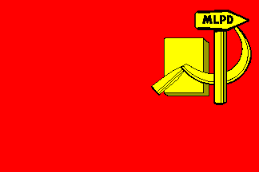 Unlike some other Maoist groups, the MLPD is not a terrorist organization and reduces its activities to constant participation in demonstrations and clashes with the police and neo-Nazi groups (the MLPD acts as one of the organizers of the three L demonstrations held in January of each year , Liebknecht and Rosa Luxemburg). In its political activities, the party works closely with other leftist associations, primarily with autonomists, but the closest ties have been established with the pro-Communist organizations of emigrants.
Unlike some other Maoist groups, the MLPD is not a terrorist organization and reduces its activities to constant participation in demonstrations and clashes with the police and neo-Nazi groups (the MLPD acts as one of the organizers of the three L demonstrations held in January of each year , Liebknecht and Rosa Luxemburg). In its political activities, the party works closely with other leftist associations, primarily with autonomists, but the closest ties have been established with the pro-Communist organizations of emigrants. The Marxist-Leninist Communist Party of Turkey (TKPM-l), which is Maoist-oriented in its ideology, has the largest and strongest branch in Europe in Germany. TKPm-l 1975 year leads to an armed guerrilla war in Turkey against the government. The confrontation between the Turkish government and the Maoist guerrillas also extends to those countries where a significant number of emigrants from Turkey live, including Germany. Repeatedly, the Maoists seized Turkish embassies and firms located in Germany, demanding the release of political prisoners in their homeland or the easing of the migration policy of the German authorities. According to the German police, among the Turkish immigrants living in Germany, several thousand are active participants in left-wing radical underground organizations.
The Latin American experience of the rural and urban guerrilla war had a great influence on the development of the German radical left movement. Ernesto Che Guevara, Fidel Castro, Regi Debre, Carlos Marigella and other heroes of the Latin American revolutionary movements became idols for several generations of the European New Left. In Germany, a whole series of organizations appeared that directly proclaim their orientation to the Latin American guerrillas. So, in 1969, there was the Tupamaros Group of West Berlin, the model for which were the Uruguayan tupamaros - urban partisans. Hevarists now include several more or less significant leftist organizations that prefer urban guerrilla warfare as the main form of struggle.
The largest Gavarist organization in Germany was the Nadi Zehadah Anti-Imperialist Resistance Cell (AIZ) group, founded in 1994 and focused on the ideological and practical experience of the Latin American revolutionary movements, the Red Army and Palestinian Terrorists. AIZ regards its activities as a protest against the militarization of the foreign policy of Germany, the exploitation by German monopolies of third world workers and the persecution of Kurdish and Turkish political emigrants by the German authorities. According to the organization’s communique, the main form of AIZ’s activity is “conducting armed operations against the elite of the Federal Republic of Germany at the place of residence and work”.
For the period from 1994 to 2000. the anti-imperialists organized a number of terrorist acts, including bombings in the homes of federal officials and outside the Peruvian embassy. Other German ultraleft AIZs are criticized for the possibility of accidental deaths, to which the ideologists of the organization say that “the majority of the metropolis itself decides whether similar actions will take place”. Anti-imperialist cells maintain close ties with the Kurdish Workers Party, the Peruvian Communist Party and the Palestinian national liberation organizations.
The first German Trotskyist groups appeared back in the 30s and were almost completely defeated by the Hitler regime before the war (with the exception of those communists who had emigrated to the United States). The revival of the Trotskyist movement in Germany is connected with the emergence at the end of the 60 of the "new left" youth interest in the works of Leonid Trotsky. It was around the middle of the 60s that the main Trotskyist organizations of modern Germany arose. All of them are guided by various Trotskyist tendencies competing with each other. The priority forms of activity for the German Trotskyists are the anti-globalization and anti-fascist struggle and agitation among the industrial proletariat and students.
Supporters of complete powerlessness
The anarchist movement in Germany has a long tradition. Before the Nazis came to power, there were numerous anarchist organizations and trade unions focused on syndicalism. The headquarters of the International Association of Workers / Anarcho-Syndicalist International (MAT / AIT) was located in Berlin until 1933. The Nazi regime virtually destroyed the bulk of the German anarchists, and up to the 60-s the number of anarchist groups was extremely small. The revival of anarchism in the Federal Republic of Germany falls on the middle of the 60-s and is associated with the emergence of an unprecedented interest among the student mass in left-wing radical political teachings, including the theory of stateless socialism.
As a result, the number of anarchist organizations has increased significantly, and a kind of ideological and organizational fusion of anarchists and more numerous, but not having their own developed ideology by new leftists, has occurred. The leading directions of German anarchism remain anarcho-syndicalism (in the tradition of the MAT / AIT) and anarcho-communism (which has practically merged with the new left). On the territory of the Federal Republic of Germany, there are a number of anarchist groups, among which several are the most numerous, active and influential.
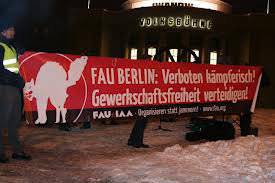 The Free Workers Union (FAU-IAA), one of the oldest anarchist groups in Germany, was founded back in 1922. FAU-IAA is the German section of the International Association of Workers / Anarcho-Syndicalist International (MAT / AIT). Ideologically, the FAU-IAA focuses on revolutionary anarcho-syndicalism and aims to build a stateless communist society as a result of a social revolution, which is understood as a general strike strike of the working people. FAU-IAA opposes the union struggle to all other forms of activity. The ideological position of FAU-IAA is dogmatist, anarcho-syndicalists prefer not to enter into alliances with other left-radical groups and are guided solely by agitation in the labor movement, in which, however, particular success was not achieved (in the composition of FAU-IAA it is significantly inferior Spanish and French anarcho-syndicalists). From the more radical anarchists, the FAU-IAA is constantly criticized for its dogmatism and moderation.
The Free Workers Union (FAU-IAA), one of the oldest anarchist groups in Germany, was founded back in 1922. FAU-IAA is the German section of the International Association of Workers / Anarcho-Syndicalist International (MAT / AIT). Ideologically, the FAU-IAA focuses on revolutionary anarcho-syndicalism and aims to build a stateless communist society as a result of a social revolution, which is understood as a general strike strike of the working people. FAU-IAA opposes the union struggle to all other forms of activity. The ideological position of FAU-IAA is dogmatist, anarcho-syndicalists prefer not to enter into alliances with other left-radical groups and are guided solely by agitation in the labor movement, in which, however, particular success was not achieved (in the composition of FAU-IAA it is significantly inferior Spanish and French anarcho-syndicalists). From the more radical anarchists, the FAU-IAA is constantly criticized for its dogmatism and moderation. The Anarchist Federation of Germany (AFD) is the German section of the International Federation of Anarchists (IFA) and the second most important anarchist organization in the country. In ideological terms, AFD focuses on classical anarcho-communism in the tradition of PA Kropotkin. The organization maintains close ties with the foreign anarcho-communist groups that make up the IFA, including the French Anarchist Federation and the Bulgarian Anarchist Federation.
Thus, we can conclude that in modern Germany the political situation is far from stable. Despite the fact that the official political life of the country looks quite decent and is characterized by opposition from conservative Christian democrats and left-wing social democrats, riots organized by left and right radicals continually occur on the streets of German cities. It is noteworthy that many leftist groups are actually funded by the state, which provides the activities of all sorts of non-profit foundations for the development of tolerance, the fight against fascism and chauvinism, which appear to be a cover for the activities of left-extremist organizations.
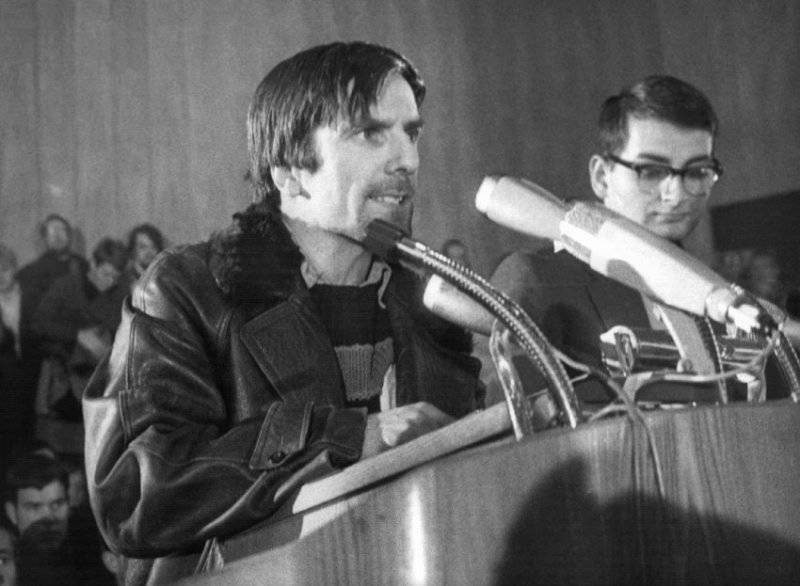
Information